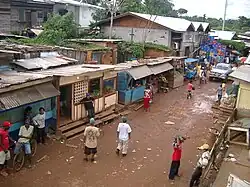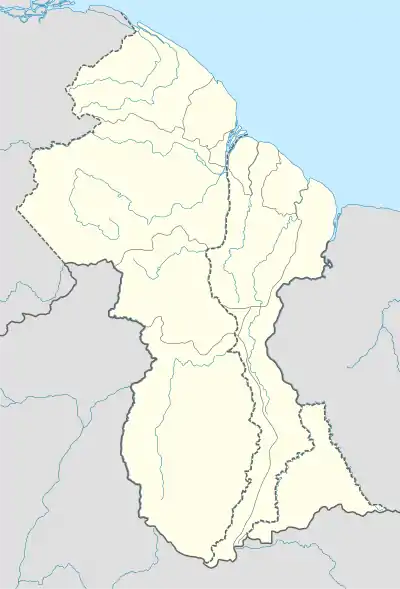Port Kaituma
Small Town | |
|---|---|
 Port Kaituma Compound | |
 Port Kaituma Location in Guyana | |
| Coordinates: 7°43′34″N 59°53′3″W / 7.72611°N 59.88417°W | |
| Country | |
| Region | Barima-Waini |
| Government | |
| • Type | Neighbourhood democratic council[1] |
| Population (2012)[2] | |
| • Total | 1,152 |
Port Kaituma is a small village within the Barima-Waini administrative region of Guyana. It became known internationally as a gateway village to the Peoples Temple settlement in nearby Jonestown. It has long been a hub for mining in the area.
History
Although an Indigenous settlement has existed along the Kaituma River for some time, it was only after the discovery of manganese at nearby Matthews Ridge[3] that Port Kaituma was developed. As Matthews Ridge was not located on a navigable river, a canal was cut from the Kaituma River and Port Kaituma was constructed.[4] At the time of the manganese mining, Port Kaituma had three separate areas. The mine managers' house and the guest house were in a large clearing separated by a short road through the forest from the main rail-head and manganese loading facility. A longer road led in the opposite direction to the area known as 'Bottom Floor' where the workers lived.
The manganese was transported from Matthews Ridge via a 64-kilometre (40 mi) railway and then shipped from Port Kaituma to Chaguaramas Bay in Trinidad, from where it was distributed for industrial use with a large proportion going to Stavanger in Norway. The project was operated by subsidiaries of Union Carbide.[5]
Two Trinidadian oil tankers, the Ambrosio and the Inverrosa, were converted into manganese carriers as part of this project. They made the trip from Port Kaituma to Chaguaramas on a regular four-day cycle for much of the 1960s. With a displacement of just under 3,000 tonnes, they were originally built in the mid 1920s with a shallow draft to ship oil across shallow sand-bars at the mouth of Lake Maracaibo in Venezuela.[6][7] The ability to slip over sand bars in very shallow water was essential to their being able to get across Waini Bar at the mouth of the Kaituma River.
Port Kaituma's significance grew further following the proclamation from the then-President of Guyana, Forbes Burnham, that Guyana should become more self-sufficient by populating the interior of the country. Matthews Ridge was highlighted as a potential new capital city,[8] and within Port Kaituma a large secondary school was constructed to educate students sent from all over Guyana. During its heyday, the school boasted over 800 students, of which most were housed in two large dormitory buildings.[9]
In the 1970s, Jim Jones' commune of Jonestown was built only 11 kilometres (7 mi) away from Port Kaituma. The first killings of the November 1978 Jonestown deaths occurred in Port Kaituma when Leo Ryan, a US Congressman from California, and others were gunned down while boarding a small Twin Otter aircraft on the local airstrip. In the aftermath and clean-up operation that ensued, the Guyanese Government prohibited any dead bodies from being buried on the site of the commune. This however didn't stop locals from scavenging the worthless garbage left behind from the property.
Over the next 25 years, a large foreign-owned logging company came and went, the manganese factory at Matthews Ridge ceased working and the railway linking Matthews Ridge and Port Kaituma was closed and in some parts cut up. The school's importance diminished and fell into a state of disrepair.
Today, Kaituma serves as the gateway to the nearby jungle where the now predominant industry of small-scale gold mining takes place.[10] The transient nature of many of these pork-knockers (gold miners) has led to problems of gun crime, robbery, murder and bribery in the unpoliced hinterlands. This however does not perturb a continual flow of workers through the town, including a recent influx of Brazilians.
Public services
Port Kaituma Community School provides nursery through secondary education. A hospital was commissioned in 2020.[11] Also in 2020, Guyana Gold Board opened an office in Port Kaituma for testing and buying gold.[12]
See also
References
- ↑ "$50M miners' block for Port Kaituma to include first bank". 3 March 2012.
- ↑ "2012 Population by Village". Statistics Guyana. Retrieved 15 August 2020.
- ↑ "$50M miners' block for Port Kaituma to include first bank". Stabroek News. 3 March 2012. Retrieved 28 January 2021.
- ↑ "The diehards still wait for a change in gold's fortunes". Stabroek News. 12 August 2016. Retrieved 28 January 2021.
- ↑ "Mining Railways in Guyana, 2014". International Steam. Retrieved 29 November 2021.
- ↑ "A story about Lago Oil tankers". www.aukevisser.nl. Retrieved 4 March 2021.
- ↑ "Ambrosio – (1926–1945)". www.aukevisser.nl. Retrieved 4 March 2021.
- ↑ "Matthews Ridge". Stabroek News. 11 March 2012. Retrieved 28 January 2021.
- ↑ "Port Kaituma Focus..." guyanaredcross.org.gy. Retrieved 28 February 2021.
- ↑ "How Guyana gold mining threatens its green future". BBC News. 26 November 2011. Retrieved 28 January 2021.
- ↑ "Port Kaituma Hospital commissioned". Stabroek News. 24 May 2020. Retrieved 28 January 2021.
- ↑ "Gold Board opening new office in Port Kaituma". Kaieteur News. 29 January 2020. Retrieved 28 January 2021.